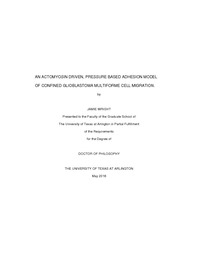
ATTENTION: The works hosted here are being migrated to a new repository that will consolidate resources, improve discoverability, and better show UTA's research impact on the global community. We will update authors as the migration progresses. Please see MavMatrix for more information.
Show simple item record
| dc.contributor.advisor | Chuong, Cheng-Jen | |
| dc.creator | Wright, Jamie | |
| dc.date.accessioned | 2016-09-28T18:50:56Z | |
| dc.date.available | 2016-09-28T18:50:56Z | |
| dc.date.created | 2016-05 | |
| dc.date.issued | 2016-05-13 | |
| dc.date.submitted | May 2016 | |
| dc.identifier.uri | http://hdl.handle.net/10106/25930 | |
| dc.description.abstract | Glioblastoma multiforme (GBM) is the most aggressive and common form of glial tumors arising in the support cells of the brain. Cell migration plays a critical role in undermining the surgical resection of tumors. Peripheral cells freely detach and invade the surrounding tissue, preferentially collecting and migrating within confined, mechanically distinct environments such as along the borders of white matter tracts and vasculature. These tracks have been mimicked experimentally using small, rectangular PDMS micro-channels. GBM cells will readily enter and migrate through these micro-channels in the absence of any chemoattractant, even without specific cell-substrate adhesion (integrins) if channel dimensions decrease to the point of dorsal-ventral compression of the nucleus. Live imaging of GBM cells with fluorescently labelled F-actin and myosin reveals that, unlike in larger channels, cells confined to the point of nuclear compression will often adopt protein distributions dissimilar to what is observed in 2D. Actin and myosin profiles are redistributed to amass at localized regions near both axial termini and diminish toward the center of the cell. A subset of these fully confined cells termed quasi-stable length (QSL) migrators will move with stable cell lengths under slight axial shortening. Because these cells are migrating in tight confinement without the usual cycles of protrusion and retraction at the front edge that accompany mesenchymal migration strategies, they make good candidates for employing possible alternative cell/substrate adhesion mechanisms. Using COMSOL, we have constructed a 3D finite element model treating the cell as a biphasic material to allow for separate tracking of the cytoskeleton and cytosol phases, whee dynamic, experimentally derived actin and myosin distribution data can be coupled with governing equations to quantitatively predict the roles and interactions of forces (adhesion, polymerization, and actomyosin contractile forces) that drive complex 3D cell migration in the absence of specific cell-substrate binding. The model is unique in that it incorporates dynamic experimental data to drive complex temporally changing behavior. While previous models have use equations describing protein reaction kinetic or integrin binding kinetics to study migration, the current model is driven by experimentally obtained distributions. The model predicts that cells can utilize transient, actomyosin-driven, pressure-dependent anchors at the cells terminal ends derived from regional actomyosin foci to create a temporary frictional foothold to overcome nucleus-channel friction and enable the cell to migrate. | |
| dc.format.mimetype | application/pdf | |
| dc.language.iso | en_US | |
| dc.subject | GBM | |
| dc.subject | Migration | |
| dc.subject | Confinement | |
| dc.subject | FEA | |
| dc.subject | Actin | |
| dc.subject | Myosin | |
| dc.subject | Cancer | |
| dc.title | AN ACTOMYOSIN DRIVEN, PRESSURE BASED ADHESION MODEL OF CONFINED GLIOBLASTOMA MULTIFORME CELL MIGRATION | |
| dc.type | Thesis | |
| dc.degree.department | Bioengineering | |
| dc.degree.name | Doctor of Philosophy in Biomedical Engineering | |
| dc.date.updated | 2016-09-28T18:51:59Z | |
| thesis.degree.department | Bioengineering | |
| thesis.degree.grantor | The University of Texas at Arlington | |
| thesis.degree.level | Doctoral | |
| thesis.degree.name | Doctor of Philosophy in Biomedical Engineering | |
| dc.type.material | text | |
Files in this item
- Name:
- WRIGHT-DISSERTATION-2016.pdf
- Size:
- 3.341Mb
- Format:
- PDF
This item appears in the following Collection(s)
Show simple item record


